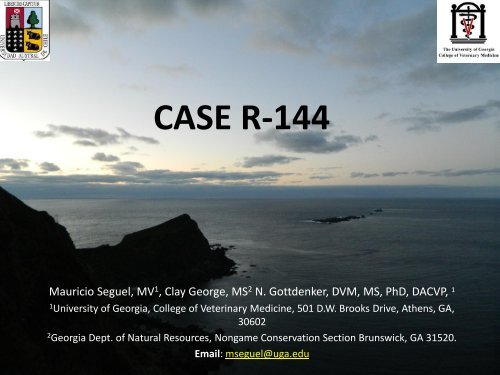CASE R-144 - University of Georgia College of Veterinary Medicine
CASE R-144 - University of Georgia College of Veterinary Medicine
CASE R-144 - University of Georgia College of Veterinary Medicine
- No tags were found...
You also want an ePaper? Increase the reach of your titles
YUMPU automatically turns print PDFs into web optimized ePapers that Google loves.
<strong>CASE</strong> R-<strong>144</strong>Mauricio Seguel, MV 1 , Clay George, MS 2 N. Gottdenker, DVM, MS, PhD, DACVP, 11<strong>University</strong> <strong>of</strong> <strong>Georgia</strong>, <strong>College</strong> <strong>of</strong> <strong>Veterinary</strong> <strong>Medicine</strong>, 501 D.W. Brooks Drive, Athens, GA,306022<strong>Georgia</strong> Dept. <strong>of</strong> Natural Resources, Nongame Conservation Section Brunswick, GA 31520.Email: mseguel@uga.edu
• Severe emaciation (1/5)Gross FindingsModerate to severepulmonary edema
• Milky fluid in airways
Intrahistiocytic microorganisms• Histoplasma capsulatum• Microsporidia• Toxoplasma gondii• Sarcocystis sp.• Cryptococcus ne<strong>of</strong>ormans• Leishmania sp.• Neospora caninum• Sporothrix schenckii
Morphologic diagnosis• Pneumonia, granulomatous and necrotizing,multifocal to coalescing, severe withnumerous intrahistiocytic yeast, etiologyconsistent with Histoplasma capsulatum.
Comments• Histoplasmosis is a common infection in the southeastern UnitedStates• Described in a large range <strong>of</strong> species including captive bottlenosedolphins (Jensen et al 1998, Venn-Watson et al. 2012)• Bottlenose dolphins in South <strong>Georgia</strong> have the highest levels <strong>of</strong>persistent organic pollutants (PCBs)reported in any marine mammal(Balmert et al. 2011)
Thanks!!!!Questions ????
















